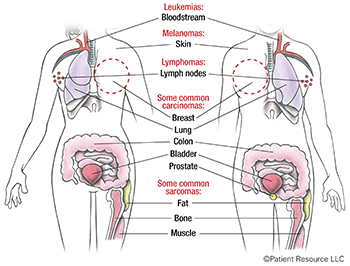Explaining Cancer
 The term cancer includes at least 100 different types of diseases that can develop in any part of the body. All of these diseases known as cancer have one thing in common — abnormal, unregulated growth of cells that can ultimately spread to vital organs, such as the liver, lung or brain.
The term cancer includes at least 100 different types of diseases that can develop in any part of the body. All of these diseases known as cancer have one thing in common — abnormal, unregulated growth of cells that can ultimately spread to vital organs, such as the liver, lung or brain.
Normal human cells, which are the basic units of the body, grow, divide and die in a predictable and orderly way. As our bodies grow and develop in childhood and adolescence, our cells divide rapidly. Once we become adults, most cells divide only to replace dying cells or repair injuries.
Cancer cells are different. Because of genetic mutations (changes in the genetic code of a gene) caused by exposure to cancer-causing agents such as too much sunlight, they continue to grow and divide, even when your body does not need new cells.
As cancer cells grow and divide, they form a disorganized mass comprised of billions of cells called a growth or a tumor. A tumor can be harmful (malignant) or harmless (benign) to your body. A malignant tumor is cancer.
Cancer cells become malignant because of changes or damage to the genetic material (DNA) in the cell that affects normal cell growth.
Benign tumors, such as warts, polyps and cysts, can usually be removed from the body, and most never return. Unlike cancer cells, they do not usually spread to other parts of the body. Cancer cells, however, can penetrate and damage adjacent organs and tissues, a process known as invasion. Cancer cells may also break away from a malignant tumor and spread to other parts of the body through the bloodstream or lymphatic system, a process known as metastasis.
Malignant tumors can spread through the blood or lymph systems to form new tumors of the same cancer type in other places in the body. When breast cancer spreads to the lung, however, it is still considered breast cancer and treated as such. It does not become lung cancer.
Various types of cancers grow at different rates and respond to different treatments. Below is a description of different types of cancer.
Types of Cancer
Carcinomas are the most common cancers. They include breast, lung and colon cancers. Carcinomas grow from cells that cover the outside of the body, such as cells in skin, and cells that cover internal body surfaces, such as cells lining the lungs. These cancers invade surrounding tissues and organs, and they can spread to the lymph nodes and other body parts.
Leukemias are immature cells arising in bone marrow that should have become functioning white blood cells. They tend to accumulate in large numbers in the bloodstream. If you have leukemia, your bone marrow produces abnormally large numbers of white blood cells that block the production of normal white blood cells, which help you fight infections, and red blood cells, which carry oxygen to tissues throughout your body. Leukemias are more common in children than adults — they account for about 25% of all childhood cancers.
Lymphomas arise in lymph nodes and other tissues of your immune system, which is the body’s defense system against infections and some cancers. Immune system tissues, or lymphoid tissues, include your tonsils and adenoids, spleen, thymus and bone marrow. There are two major types of lymphomas: Hodgkin lymphoma and non-Hodgkin lymphomas. Lymphomas can also spread to other organs and are most dangerous when they crowd out production of normal white blood cells in the marrow or lymphoid tissues.
Melanomas are the most serious types of skin cancer. They initially appear on the surface of the skin as a change in the shape, size, color or feel of a mole. Most malignant melanomas have an area that is black or blue-black in color. If detected when they first appear, they are easy to treat. However, if allowed to grow, they can grow down into skin, reach blood vessels and lymphatic vessels and spread through the body, resulting in a life-threatening illness. Most melanomas form on the skin but can also form in other pigmented tissues, such as the eye.
Sarcomas grow from cells in connective or supportive tissue in the body, such as bone, cartilage, joints, muscle, fat, nerves, deep skin tissues and blood vessels. These are relatively rare cancers, accounting for about 1% of all cancers. They include bone tumors called osteosarcomas, fat-tissue tumors called liposarcomas and smooth-muscle tumors called leiomyosarcomas.


